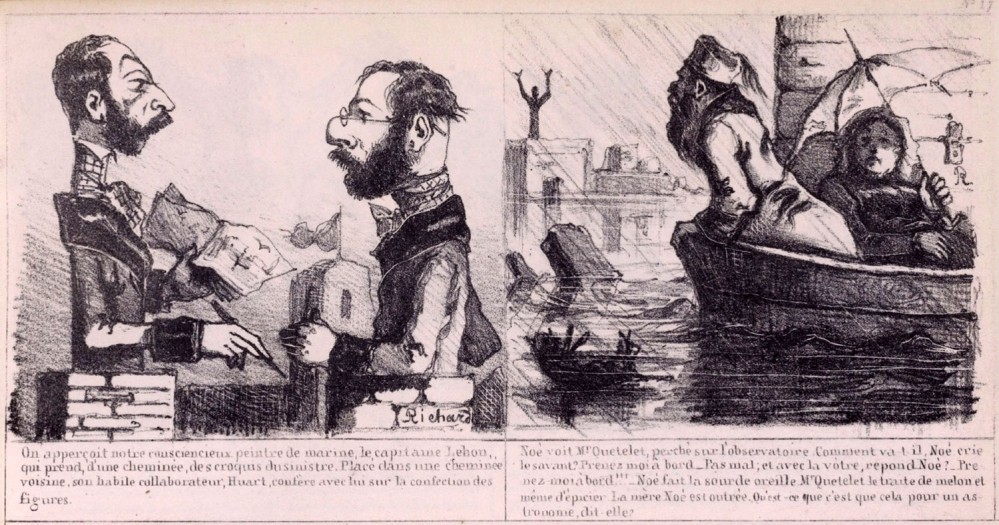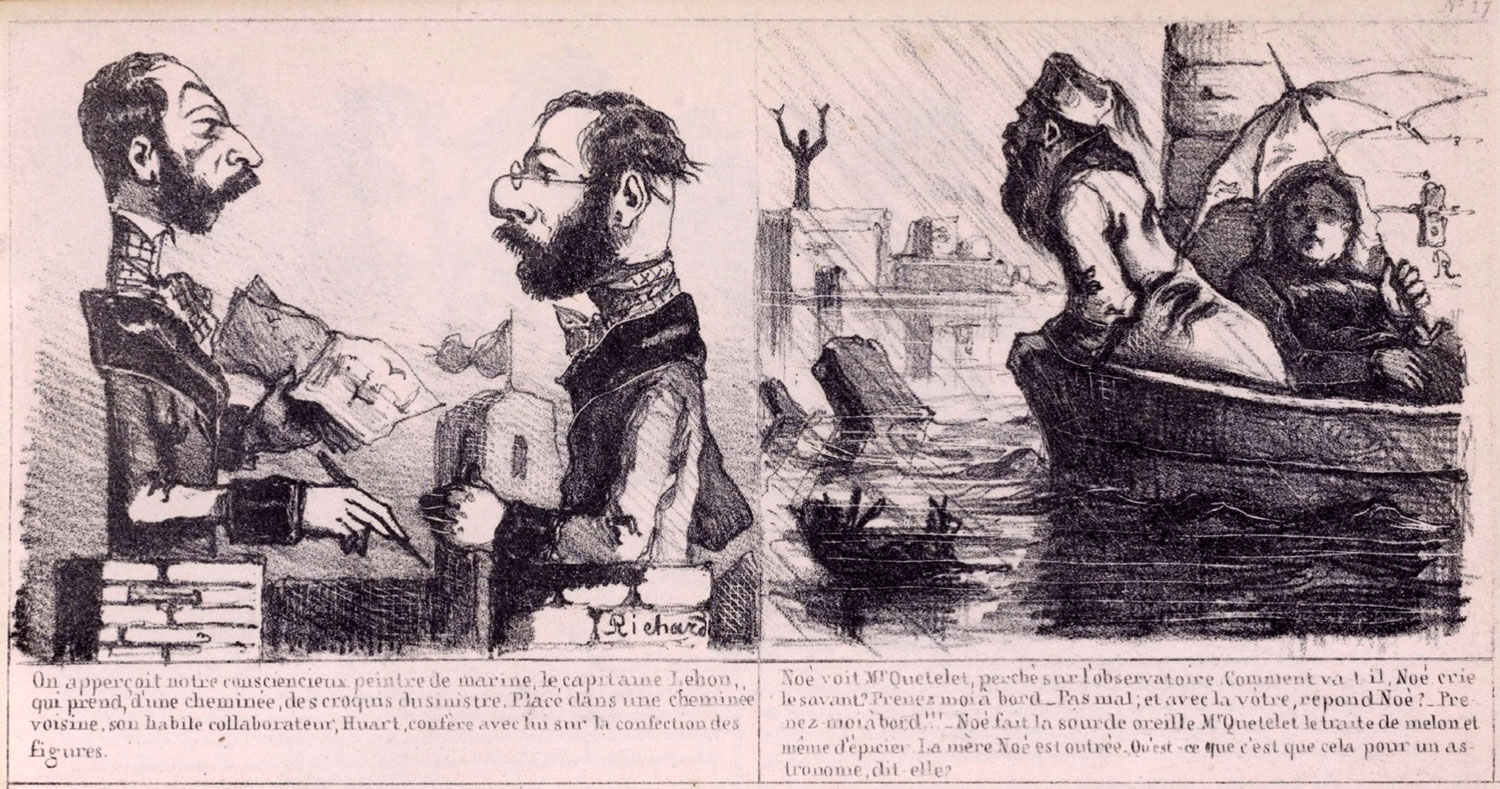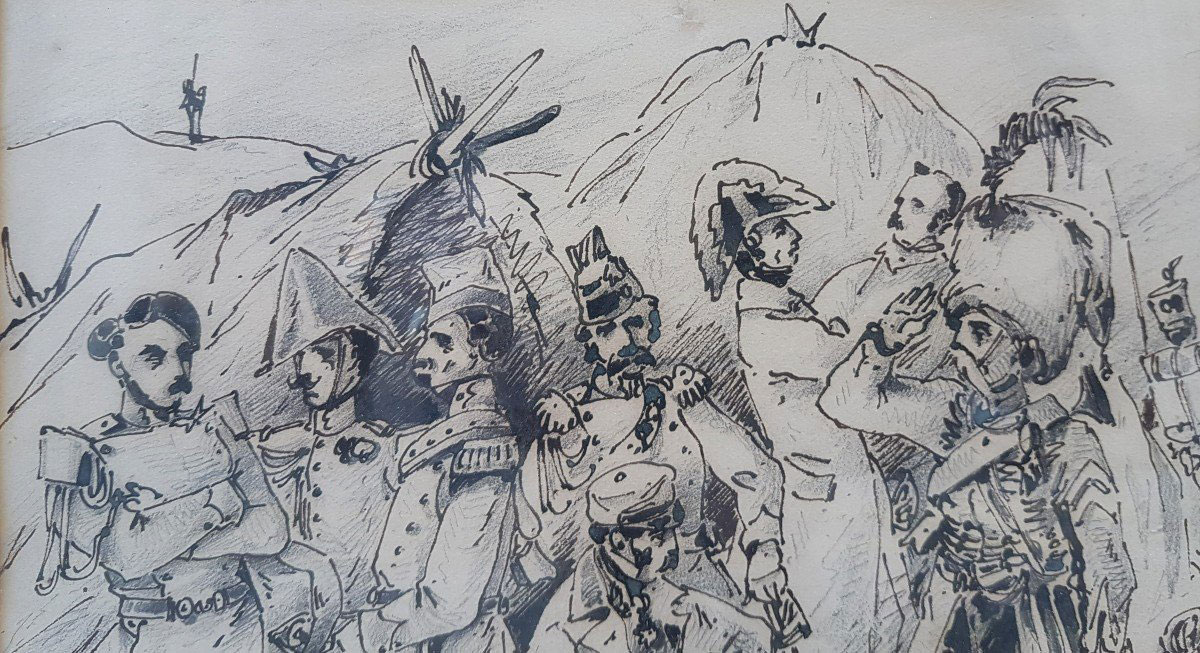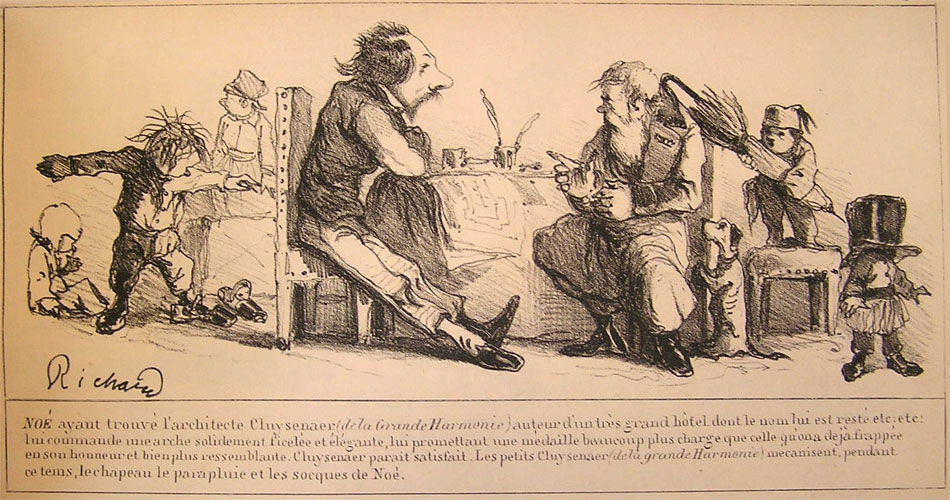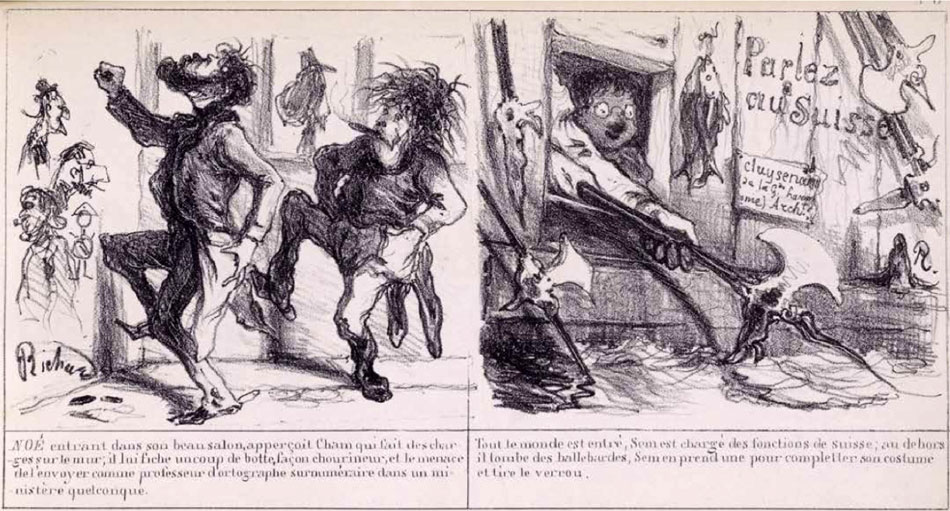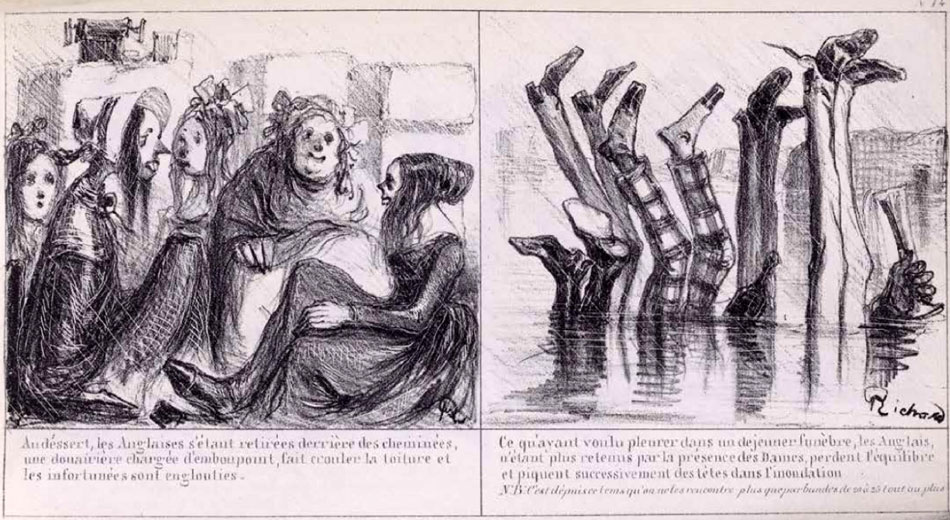'Le Déluge à Bruxelles' (1843).
Richard de Querelles was a 19th-century French-Belgian military commander, graphic designer, illustrator and sculptor. His one-shot comic strip 'Déluge à Bruxelles' (1843) holds historical significance as the first official comic book released on Belgian soil, making Richard de Querelles, together with Félicien Rops, the earliest Belgian comic artist who can be identified by signature. Being set in the capital Brussels and featuring celebrity cameos, 'Déluge à Bruxelles' is additionally important as the first Belgian comic book with surreal comedy, a fantasy/science fiction plot and a distinctive regional atmosphere.
Life and career
Henri Sigfried Richard, count of Querelles, was born in 1811 in Neuwiller-lès-Sayerne, a town in the North Eastern region of Bas-Rhin, France. His father was a general in Napoleon Bonaparte's army. In the early 1830s, Querelles followed in his footsteps, serving in the French army, moving up to the rank of battalion commander and commander of the foot guards of the Imperial Guard. The latter were a militia who supported the ideology of Napoleon Bonaparte, who had been deposed in 1815 and died in 1821, but who still remained popular. Under command of one of Napoleon's cousins, Louis-Philippe (the later president and emperor Napoléon III), the Imperial Guard attempted two coups, in 1836 and 1840, which both failed. Louis-Philippe fled across the borders, and went into exile. As one of his lieutenants, Querelles was in 1836 charged with treason and as an accomplice in a plot to overthrow the state. According to official legal documents, De Querelles lived in the Rue de Fontaine 24 in Strasbourg at the time and was described as "(…) grand, blond et porte moustache; son nez est aquilin" ("large, blonde, with a moustache and eagle nose"). He was imprisoned in the military prison in L'Abbaye in Paris, but already released by 18 January 1837.
"Souvenir of a Barrack of Officers" (1830 drawing).
In 1840, Querelles married Hortense Louise Françoise de Beauharnais (1812-1851), who should not be confused with her cousin, Hortense de Beauharnais (1783-1837), wife of the Dutch king Louis Bonaparte (and the brother of Napoleon Bonaparte). The same year, Querelles was charged with participating in Louis-Philippe's failed coup in Boulogne, but wasn't present at the trial. Instead, he lived in exile in London and, from 1843 on, in Brussels. In the mid-19th century, Brussels was a safe haven for political refugees: the German writer Karl Marx for instance wrote 'The Communist Manifesto' in the Belgian capital. Richard de Querelles passed away in 1846 in Paris, at age 35. He was buried at the famous graveyard Père Lachaise, where his grave can still be visited today. De Querelles didn't live to see Louis-Philippe eventually becoming the new French head of state in 1848, when he was elected President and became emperor Napoléon III (1850-1870).
Apart from his military activities, De Querelles also had an artistic career. He made engravings and sculptures and was an apprentice of Nicolas-Toussaint Charlet. De Querelles and his wife were also friends with Eugène Délacroix (of the painting 'Liberty Guides The People' fame). De Querelles published some caricatures and illustrations in the French magazine L'Illustration, signing them with his first name, "Richard".
'Le Déluge à Bruxelles' (1843).
Le Déluge à Bruxelles
In 1843, Richard de Querelles drew a full-blown picture story, 'Le Déluge à Bruxelles' ("The Brussels Flood"). The comic is set in Brussels and revolves around a huge flood that sets the city under water. Noë (the French name of the biblical character Noah, but also a reference to Amedée de Noë, the real name of French cartoonist Cham) decides to build an arc. The story describes the events before, during and after the aquatic disaster. Given that rainy weather and occasional floods in the streets have always been a recurring phenomenon in Belgium, Querelles obviously didn't have to look far for inspiration. De Querelles drew his comic in the studio of Jules Géruzet, a lithographer and photographer who, like him, had also immigrated from France and had printed comics by Cham for Belgian audiences. Stylistically, Querelles' comic shows clear graphic influence from both Cham and Rodolphe Töpffer.
'Le Déluge à Bruxelles' is a text comic, with text printed underneath the images. Overall, the plot is a bit rambling, with Querelles frequently interrupting the main narrative to make winks and inside jokes regarding well-known people from the city. Various hotspots in the Belgian capital, like the Café Suisse and the Place de la Bourse/Beursplein, are mentioned. Some well-known citizens of the time have cameos, like the architect Jean-Pierre Cluysenaar and the mathematician Adolphe Quetelet, often complete with their home addresses. In one scene, Noë meets Leopold I, the first king of Belgium, but "since the fog is so thick", the panel is left completely blank. Underneath this empty drawing, the reader is informed that "the Royal Crown is covered because of constitutional issues." In the 19th century, portraying the monarch was still a punishable offense, so Querelles and his publisher presumably wanted to avoid lesé-majesté. Yet the authors took the opportunity to turn this absurd situation into another joke with Querelles informing readers that "his publisher will prosecute people who falsify this drawing with a severance previously unseen in our regions."
De Querelles' publisher, Jules Géruzet, also receives a guest role and Noë discovers remnants of well-known Belgians, like the riding whip of general Pierre-Joseph Le Charlier, who was one of the resistance fighters during the Belgian Independence War (1830). Some comedy is very black. When various sweets and candy stores flood, the narrator mentions that "several children die from a sugarwater overdose." A group of English tourists is killed when an obese widow crashes through the roof. The narrator adds: "Since then, they are only seen in groups of merely 20 to 25 people."
'Le Déluge à Bruxelles' (1843).
'Le Déluge à Bruxelles' is the first known comic strip created and published on Belgian soil. Printed in 1848, it is also the first known Belgian comic book. Modeled after foreign examples, the story was released in the landscape format. De Querelles pioneered the first of many Belgian humorous adventure comics with a regional atmosphere, a format that remains popular with its citizens until this day. The cameos from Brussels celebrities makes it the earliest known Belgian satirical comic and celebrity comic. The "flooded city" plot gives it the additional honor of being the earliest example of a Belgian fantasy or science fiction comic. Querelles even proves himself a precursor of Belgium's association with surrealism and absurd comedy. In one scene, the narrator claims that "it's raining halberds" (an outdated proverb comparable to the nowadays more common "it's raining cats and dogs"), with several medieval axes indeed literally raining down. Noë's son, Sem, even plucks one from the sky.
Before Querelles, the only artists who occasionally made sequential engravings or paintings in what is now the country of Belgium have remained anonymous. Among the few that can be identified by name are Pieter Bruegel the Elder, Frans Hogenberg and Jan Christoffel Jegher. Querelles holds historical significance as the first comic artist to debut after Belgium became independent in 1830. However, since he was born in France, he was not the first genuine Belgian comic artist. That honor should go to Félicien Rops, who in 1853 serialized 'Les Époux Van-Blague', a text comic in the magazine Le Crocodile. Interestingly enough, Rops was also influenced by Cham and signed his early work with the pseudonym "Cham-Loth". Much like Querelles, he too drew a comic story set in Brussels, titled 'Mr. Coremans aut Tir National' (1861).
A copy of 'Le Déluge à Bruxelles' is held in the Cabinet des Estampes/ Picture Cabinet in the Royal Library of Brussels.
Other picture stories
After his first effort, Raymond de Querelles created more prototypical picture stories. Printed on 28 September 1844 in an issue of L'Illustration, De Querelles published 'Les Bains de Mer Belges' ("The Belgian Bath City"). The story is a humorous reflection on a visit by him and his wife to the Belgian coastal city Ostend, popularly nicknamed "the Queen of Bath Cities". While the anecdotes are told in a written text, De Querelles livens up his tale with funny drawings and caricatures. De Querelles also made another illustrated article, 'Association Belge Philanthropique des Frères d'Armes de l'Empire Français, Institué à Bruxelles le 12 Juillet 1838'. The text, printed on 16 November 1844 in L'Illustration, reflects on the philanthrophic organisation "Brothers in Arms of the French Empire", and particularly its dean, Pierre Joseph Dereume. De Querelles' drawings, 11 in total, make the article more visually interesting.
Legacy and influence
Despite his pioneering role in the history of Belgian comics, Richard de Querelles remains a largely forgotten figure. Many 19th-century and early 20th-century Belgian magazines and newspapers occasionally printed picture stories in their pages, though most were imported from France, England, Germany and the United States. Some local artists provided material from time to time, but most of their contributions were unsigned. Even the few artists whose names have been saved from oblivion had little overall impact until Hergé's 'Tintin' (1929) launched the modern-day Belgian comic industry. It wasn't until the publication of Danny De Laet's 'De Geschiedenis van het Beeldverhaal in Vlaanderen' ("The History of the Flemish Comic Strip", 1977) that De Querelles' 'Déluge à Bruxelles' received academic attention. In the very first issue of Zandstraal/ Le Dessableur (March 2021), the official magazine of the Belgian Comic Strip Center in Brussels (March 2021), Querelles' life story was adapted into a short comic strip by Frédéric Paques and Hugo Piette.


